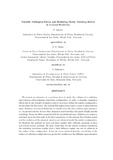| dc.rights.license | http://creativecommons.org/licenses/by-nc-sa/3.0/ve/ | |
| dc.contributor.author | Núñez, Luis | es_VE |
| dc.contributor.author | Aguirre M., Felix | es_VE |
| dc.contributor.author | Soldovieri, T. | es_VE |
| dc.date | 2006-01-26 | es_VE |
| dc.date.accessioned | 2006-01-26T09:00:00Z | |
| dc.date.available | 2006-01-26T09:00:00Z | |
| dc.date.created | 2005-03-01 | es_VE |
| dc.date.issued | 2006-01-26T09:00:00Z | es_VE |
| dc.identifier.other | T016300001936/0 | es_VE |
| dc.identifier.uri | http://www.saber.ula.ve/handle/123456789/17088 | |
| dc.description.abstract | Variable Eddington Factor and Radiating Slowly Rotating Bodies in General Relativity
(Núñez, Luis; Aguirre, Felix; Soldovieri, T.)
Abstract
We present an extension to a previous work to study the collapse of a radiating, slow-rotating self-gravitating relativistic configuration. In order to simulate dissipation effects due to the transfer of photons and/or neutrinos within the matter configuration, we introduce the flux factor, the variable Eddington factor and a closure relation between them. Rotation in General Relativity is considered in the slow rotation approximation, i.e. tangential velocity of every fluid element is much less than the speed of light and the centrifugal forces are little compared with the gravitational ones. Solutions are properly matched, up to the first order in the Kerr parameter, to the exterior Kerr-Vaidya metric and the evolution of the physical variables are obtained inside the matter configuration. To illustrate the method we work out three models with different equations of state and several closure relations. We have found that, for the closure relations considered, the matching conditions implies that a total diffusion regime can not be attained at the surface of the configuration. It has also been obtained that the eccentricity at the surface of radiating configurations is greater for models near the diffusion approximation than for those in the free streaming out limit. At least for the static "seed" equations of state considered, the simulation we performed show that these models have differential rotation and that the more diffusive the model is, the slower it rotates. | es_VE |
| dc.language.iso | es | es_VE |
| dc.publisher | SABER ULA | es_VE |
| dc.rights | info:eu-repo/semantics/openAccess | |
| dc.subject | Distribuciones autogravitantes | es_VE |
| dc.title | Variable Eddington Factor and Radiating Slowly Rotating Bodies in General Relativity | es_VE |
| dc.type | info:eu-repo/semantics/article | |
| dc.description.email | nunez@ula.ve | es_VE |
| dc.description.email | aguirre@ula.ve | es_VE |
| dc.description.email | tsoldovieri@luz.edu.ve | es_VE |
| dc.description.tiponivel | Nivel monográfico | es_VE |
| dc.subject.centroinvestigacion | Centro de Física Fundamental (CFF) | es_VE |
| dc.subject.centroinvestigacion | Centro Nacional de Cálculo Científico (CeCalCULA) | es_VE |
| dc.subject.facultad | Facultad de Ciencias. | es_VE |
| dc.subject.keywords | Stars: rotation | es_VE |
| dc.subject.keywords | Stars: neutron | es_VE |
| dc.subject.keywords | Radiative transfer | es_VE |
| dc.subject.keywords | Equation of state | es_VE |
| dc.subject.keywords | Gravitation | es_VE |
| dc.subject.keywords | Relativity | es_VE |
| dc.subject.tipo | Artículos | es_VE |


